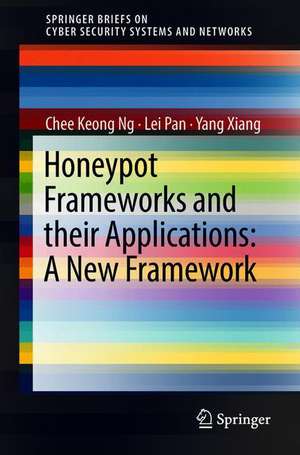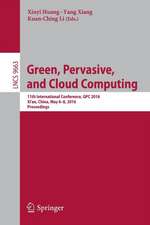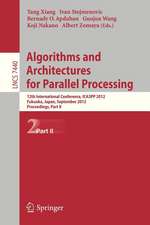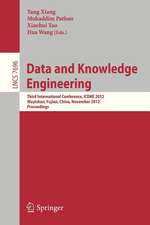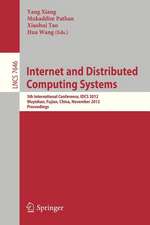Honeypot Frameworks and Their Applications: A New Framework: SpringerBriefs on Cyber Security Systems and Networks
Autor Chee Keong NG, Lei Pan, Yang Xiangen Limba Engleză Paperback – 21 mai 2018
The book subsequently tackles the issue of honeypot countermeasures, shows many of the tricks often used by hackers to discover honeypots, and proposes a counter-countermeasure to help conceal them. It then puts forward a new framework that integrates various novel concepts, and which can feasibly be used for the detection of potential ransomware and bitcoin. As such, the book provides non-experts with a concise guide to honeypots, and will also benefit practitioners working on security systems.
Preț: 322.16 lei
Preț vechi: 402.70 lei
-20% Nou
Puncte Express: 483
Preț estimativ în valută:
61.65€ • 64.13$ • 50.90£
61.65€ • 64.13$ • 50.90£
Carte tipărită la comandă
Livrare economică 10-16 aprilie
Preluare comenzi: 021 569.72.76
Specificații
ISBN-13: 9789811077388
ISBN-10: 981107738X
Pagini: 75
Ilustrații: XII, 81 p. 5 illus. in color.
Dimensiuni: 155 x 235 mm
Ediția:1st ed. 2018
Editura: Springer Nature Singapore
Colecția Springer
Seria SpringerBriefs on Cyber Security Systems and Networks
Locul publicării:Singapore, Singapore
ISBN-10: 981107738X
Pagini: 75
Ilustrații: XII, 81 p. 5 illus. in color.
Dimensiuni: 155 x 235 mm
Ediția:1st ed. 2018
Editura: Springer Nature Singapore
Colecția Springer
Seria SpringerBriefs on Cyber Security Systems and Networks
Locul publicării:Singapore, Singapore
Cuprins
1 Honeypot Introductory.- 2 Honeypot.- 3 The Application of Honeypot.- 4 Detecting Honeypots and their Counter-measure.- 5 Ramsonware and Honeypot.- 6 Honeypot Frameworks.- 7 Conclusion and Future Work.
Notă biografică
Chee Keong NG completed his Master of IT at Deakin University, Australia. He is now pursuing his PHD in Philosophy (IT). His research interests include honeypots, ransomware and deep learning.
Dr Lei Pan received his Ph.D. in Computer Forensics from Deakin University, Melbourne, Australia, in 2008. He currently teaches at Deakin University, Burwood, Victoria, Australia, where he offers courses on cybersecurity. His research interests include cybersecurity and privacy, software security testing, and the applications of analytics in security and privacy. He is also an active cybersecurity educator on futurelearn.com.
Professor Yang Xiang received his PhD in Computer Science from Deakin University, Australia and is currently the Dean of the Digital Research & Innovation Capability Platform at Swinburne University of Technology, Australia. His research interests include network and system security, data analytics, distributed systems, and networking. Further, he is a Senior Member of the IEEE.
Dr Lei Pan received his Ph.D. in Computer Forensics from Deakin University, Melbourne, Australia, in 2008. He currently teaches at Deakin University, Burwood, Victoria, Australia, where he offers courses on cybersecurity. His research interests include cybersecurity and privacy, software security testing, and the applications of analytics in security and privacy. He is also an active cybersecurity educator on futurelearn.com.
Professor Yang Xiang received his PhD in Computer Science from Deakin University, Australia and is currently the Dean of the Digital Research & Innovation Capability Platform at Swinburne University of Technology, Australia. His research interests include network and system security, data analytics, distributed systems, and networking. Further, he is a Senior Member of the IEEE.
Textul de pe ultima copertă
This book presents the latest research on honeypots and their applications. After introducing readers to the basic concepts of honeypots and common types, it reviews various honeypot frameworks such as web-server-based, client-based, shadow and artificially intelligent honeypots. In addition, it offers extensive information on the contribution of honeypots in some of the most popular malware research area such as DDoS, Worm, APT, forensics and Bot attacks.
The book subsequently tackles the issue of honeypot countermeasures, shows many of the tricks often used by hackers to discover honeypots, and proposes a counter-countermeasure to help conceal them. It then puts forward a new framework that integrates various novel concepts, and which can feasibly be used for the detection of potential ransomware and bitcoin. As such, the book provides non-experts with a concise guide to honeypots, and will also benefit practitioners working on security systems.
The book subsequently tackles the issue of honeypot countermeasures, shows many of the tricks often used by hackers to discover honeypots, and proposes a counter-countermeasure to help conceal them. It then puts forward a new framework that integrates various novel concepts, and which can feasibly be used for the detection of potential ransomware and bitcoin. As such, the book provides non-experts with a concise guide to honeypots, and will also benefit practitioners working on security systems.
Caracteristici
Provides several helpful tactics for honeypot detection and deflection Especially helpful for non-experts, thanks to its comprehensive and accessible content Offers a reference guide for readers interested in honeypots and their applications in various fields
